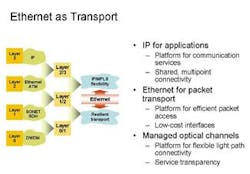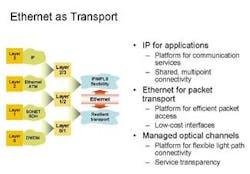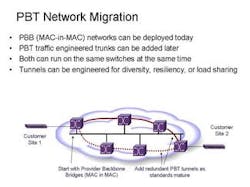Both PBT and T-MPLS provide the latest evolutionary step in Layer 2 networks by providing the traffic engineering capabilities necessary to achieve the determinism and resiliency needed for today's advanced real-time services.
By Peter Lunk, Extreme Networks
Unbeatable cost economies continue to drive Ethernet's inexorable march into the metro network. Many innovative carriers have rolled out real-time services for both business and residential subscribers based on a converged Ethernet infrastructure. However, as carriers with a significant investment in SONET/SDH gear look to upgrade their networks, it has become clear that Ethernet needs to evolve once again.
As SONET/SDH networks run into bandwidth scalability limits, carriers are looking for new technology options that provide more bandwidth and improved economics, yet maintain their existing operational model with deterministic network behavior. This enables a smooth transition away from legacy gear toward a network model in which Ethernet provides a packet transport layer that sits between the WDM-based optical layer and the IP-based service layer (see Figure 1).
Two approaches have been proposed to address the deterministic packet transport layer. The first, called transport MPLS (T-MPLS), builds on existing multiprotocol label switching (MPLS) standards. The second, known as Provider Backbone Transport (PBT), extends the proposed IEEE 802.1ah Provider Backbone Bridges standard. Both approaches strive to add the traffic engineering capabilities of SONET/SDH to Layer 2 network designs.
Traffic engineering
The automated learning mechanisms in Ethernet and the routed label-switched path setup of MPLS prevent the direct control of traffic flows through the network. Both T-MPLS and PBT look to bypass this automatic configuration to bring traffic engineering to the next-generation network. One important benefit of traffic engineering is efficient failover capability. By allowing pre-provisioned backup paths through the network, T-MPLS and PBT significantly improve the restoration process, and 50-msec failover times become possible for packet-based networks. This minimizes service disruptions for time-sensitive services like voice over IP (VoIP) and IPTV and helps improve the customer experience.
The metrics involved in routing algorithms and Spanning Tree calculations often will lead to certain paths being selected more often than others. As network utilization increases, certain links can be overloaded, while others sit idle. Traffic engineering solves this problem by providing the control required to balance the use of precious network resources. Additionally, traffic engineering enables the service provider to create route diversity, which minimizes the risk of a single link or device failure causing a simultaneous interruption to both the primary and backup path through a network.
Finally, traffic engineering capabilities preserve a familiar operational model that takes advantage of the carrier's investment in training and back-office systems. This, in turn, lowers the hurdles for migrating to the transport technology required to effectively support profitable high-bandwidth, real-time services.
PBT and T-MPLS
PBT and T-MPLS both extend traffic engineering capabilities to Ethernet in a similar manner. Specifically, PBT disables the automatic learning mechanisms on the Ethernet control plane so carriers can manage traffic paths directly. T-MPLS achieves the same end by stripping out the control plane from traditional MPLS. In both cases, configuration and provisioning functionality is moved up to the network management level.
The primary building blocks upon which PBT is built are the IEEE-proposed Provider Backbone Bridging and Configuration Fault Management (CFM) standards. Provider Backbone Bridging significantly increases Ethernet scalability to millions of VLANs and overcomes the issue of ever-expanding MAC table sizes. PBT replaces the automatic learning mechanisms, as well as flooding and broadcasting of traffic, with the ability to define dedicated circuits (tunnels) on an individual VLAN basis without disrupting this new extended scalability. Because PBT allows the VLAN ID space to be divided into a normal Ethernet domain and a PBT domain, a single switch can support both bridged and point-to-point behavior. PBT uses CFM continuity check messages (CCM) to monitor the health of the various paths through the network. Because the CCM rate is configurable, it can easily be set to a frequency that enables carrier-class failover recovery within 50 msec. Additionally, the base hardware necessary to support PBT is already available in products shipping today; the migration to PBT, therefore, can be accomplished via a software upgrade (see Figure 2).
T-MPLS is based on a profile of several existing standards, as MPLS already has many of the mechanisms in place to provide traffic engineering capabilities within a resilient architecture. The MPLS equivalent of a PBT tunnel is the label-switched path (LSP). However, LSPs differ from tunnels in that some MPLS capabilities such as LSP merging and penultimate hop popping can disrupt end-to-end continuity checks. These MPLS capabilities must be eliminated in T-MPLS to ensure reliability.
T-MPLS was developed in response to the inherent complexity of MPLS implementations. By simplifying MPLS, T-MPLS provides the key functions necessary for traffic engineering and offers many advantages for carriers and service providers who are already proficient with MPLS technology. For those not familiar with MPLS, however, this is only a partial benefit. To a large extent, T-MPLS is simply a matter of choosing specific pieces of the MPLS standard while avoiding others. This means one still must have MPLS expertise in order to make these choices. As a result, T-MPLS is still fairly complex.
In contrast, most network operators have Ethernet experience in some form. From this perspective, even using a simplified version of MPLS requires significantly more training when compared with PBT. In any case, many of the new services driving the change in network architecture, such as the Metro Ethernet Forum (MEF) E-Line and E-LAN services, are Ethernet based. Not only is there a fundamental advantage in carrying Ethernet services natively over Ethernet, but PBT allows service providers to avoid the steep MPLS learning curve in the metro network.
Another important aspect in carrier networks is the ability to extend service reach through peering. For example, a customer with multiple locations may have a few locations that are not served by the customer's carrier of choice. Peering agreements between carriers enable these out-of-footprint sites to be serviced by the subscriber's carrier of choice.
Historically, there have been only very limited MPLS-based peering agreements between carriers. PBT, by contrast, is Ethernet-based; it can take full advantage of the MEF work on an Ethernet Network-to-Network Interface (NNI) specification to allow efficient and widespread peering of Ethernet services.
Industry support and commitment
PBT is being driven by the IEEE, and the 802.1 committee recently agreed to formulate a project authorization request proposal for submission to the executive committee. It is anticipated that the formal name for the project will be "Provider Backbone Bridge support for Traffic Engineering," or PBB-TE. With a lot of hard work and a bit of luck, this could reach a sponsor ballot phase by summer of 2008. As key industry players have already scheduled interoperability testing for later this year, products should be ready for delivery in the same timeframe.
T-MPLS is being developed under the ITU umbrella, and while it seems to be getting some attention, there has been a noticeable lack of carrier support. On the PBT side, there is a growing list of carriers that have publicly disclosed plans to implement this new technology.
Both PBT and T-MPLS represent the latest evolutionary step in Layer 2 networks by providing the traffic engineering capabilities necessary to achieve the determinism and resiliency needed for today's advanced real-time services. While PBT and T-MPLS appear to be more similar than they are different, there is one key difference to note when it comes to costs: The economies of scale inherent in Ethernet promise the best overall return on investment for a carrier upgrading its infrastructure. In the increasingly competitive service provider business, that difference will likely determine the relative success of these two technologies.
Peter Lunkis director of service provider marketing at Extreme Networks. He may be reached via the company's web site at www.extremenetworks.com.


